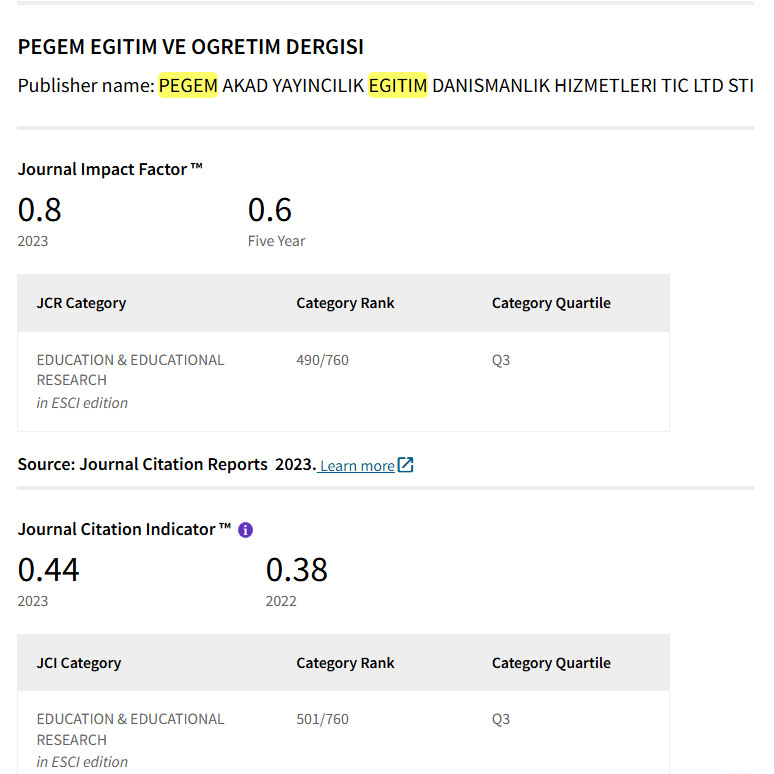Prospective Foreign Language Teachers: Interactive Whiteboards Within the Context of Micro-Learning
DOI:
https://doi.org/10.47750/pegegog.14.04.12Keywords:
prospective teachers, foreign language, interactive whiteboard, micro-learningAbstract
The growth in the amount of data and access to information together with developing technology, has led to changes in the needs of individuals and society as a whole. The development of teacher knowledge is very important in educational field. Based on this necessity, the opinions of candidate foreign language teachers on the use of the interactive whiteboard within the context of micro-learning, have emerged as the hotspot of this research. This research study has a quantitative feature based on survey methods. The total participant number is 101 candidate (prospective) foreign language teachers. The participants are senior-year learners of the English Language and Literature Department at the Faculty of Letters in Karabük University- Türkiye, who undertook pedagogical training in the 2023-2024 AY, Autumn term. A 5-point Likert type questionnaire was distributed among the students and the statistical analyses of the survey were performed using the IBM-SPSS Statistics, Version 23·0 program.
Downloads
References
Akgün, M. & Koru Yücekaya, G. (2015). Akıllı tahta kullanımına yönelik öğrenci tutumu ve öğretmen görüşlerinin incelenmesi (Ankara ili örneği). NWSA Qualitative Studies, 10 (3), 1-11.
Altın, H. M., & Kalelioğlu, F. (2015). Fatih Projesi ile ilgili Öğrenci ve Öğretmen Görüşleri. BaşKent University Journal Of Education, 2(1), 89-105. R
Altınçelik, B. (2009). İlköğretim düzeyinde öğrenmede kalıcılığı ve motivasyonu sağlaması yönünden akıllı tahtaya ilişkin öğretmen görüşleri. (Unpublished Master Thesis.). Sakarya Üniversitesi, Sakarya.
Badrul, K., H., Saida, A., Soheil, H. S., & Zuheir, N. K. (2021). Challenges and Opportunities for the Global Implementation of E-Learning Frameworks. IGI Global.
Baydaş̧, Ö., Esgice, M., Kalafat, Ö., & Göktaş, Y. (2011). Etkileşimli tahtaların öğretim süreçlerine katkıları. 5th International Computer & Instructional Technologies Symposium. Fırat Üniversitesi, Elazığ.
Bidaki, M. Z., & Mobasheri, N. (2013). Teachers’ Views of the Effects of the Interactive White Board (IWB) on Teaching. Procedia - Social and Behavioral Sciences, 83, 140-144.
Bozkurt, A. (2014). Ağ toplumu ve öğrenme: bağlantıcılık. Akademik Bilişim, 2014, Mersin: Mersin Üniversitesi, pp.601-606.
Çelik, S. (2012). Competency Levels of Teachers in Using Interactive Whiteboards. Contemporary Educational Technology, 3(2), 115-129. Retrieved on March 20, 2023, at http://dergipark.org.tr/cet/issue/25728/271457.
Fitria, T. N. (2022). Students’ Readiness of the Implementation of Face-To-Face Learning at English Class in the Academic Year 2021/2022. ETERNAL (English, Teaching, Learning, and Research Journal), 8(1), Article 1. https://doi.org/10.24252/Eternal.V81.2022.A13
Görü-Doğan, T. & Eby, G. (2013). Uzaktan bilgisayar mühendisliği eğitimi: sosyoteknik kuram çerçevesinde esnek bir model önerisi. Ankara: Kültür Ajans.
Grovo, H. Q. (2015). Bite size is the right size: how microlearning shrinks the skills gap in higher education. www.trainingindustry.com/content-development/articles/bite-size-isthe-right-size-how-microlearning-shrinks-the-skills-gap.aspx, retrieved, June 19, 2023.
Gündüz, M. (2013). Modern eğitimin doğuşu ve alternatif eğitim paradigmaları. Bayburt Üniversitesi Eğitim Fakültesi Dergisi. Özel Sayı 1: 66-80.
Hug, T. (2006). Microlearning: a new pedagogical challenge. T. Hug, M. Lindner & P. A. Bruck (Eds), Microlearning: emerging concepts, practices and Technologies after e-learning . Innsbruck University Press
Illich, I. (2017). Okulsuz toplum (Çev. M. Özay). İstanbul: Şule Yayınları.
Job, M. A., Ogalo, H. S. (2012). Micro-learning as innovative process of knowledge strategy. International Journal of Scientific & Technology Research, 1 (11), 92-96.
Kukulska-Hulme, A., Traxler, J. (2007). Designing for mobile and wireless learning. H. Beetham, R. Sharpe. (Eds.), Rethinking pedagogy for a digital age (180-192): Oxon: Taylor & Francis E-Library.
Kukulska-Hulme, A., Norris, L., & Donohue, J. (2015). Mobile pedagogy for English language teaching: a guide for teachers. London: British Council.
Murat, D. (2016). English language instructors' perceptions and use of interactive whiteboards in English as a foreign language classrooms (Unpublished Master Thesis). İstanbul: Bahçeşehir University.
Siemens, G. (2005). Connectivism: learning as network creation. http://www.elearnspace.org/, retrieved on, July 24, 2023.
Söderberg , K. (2023). What Is The Deal With Microlearning, ISBN 978-91-89757-72-1, Retrieved on October 10, 2023, https://www.diva-portal.org/smash/get/diva2:1744733/FULLTEXT01.pdf
Spodick, E. F. (1995). The evolution of distance learning. 1st Asian Information Meeting, Hong Kong, pp. 77-88.
Traxler, J. (2005). Defining mobile learning. the IADIS International Conference: Mobile Learning, Malta, pp. 261-266.
Wedemeyer, C. A. (1981). Learning at the back door reflections on non-traditional learning in the lifespan. Madison: University of Wisconsin Press.
Yıldırım, H. (2017). Mobil öğrenme: meslek yüksekokullarında bilginin yeniden yapılandırılması üzerine bir durum çalışması. (Unpublished Master Thesis).. Eskişehir: Anadolu Üniversitesi, Sosyal Bilimler Enstitüsü.
Downloads
Published
How to Cite
Issue
Section
License
Copyright (c) 2024 Pegem Journal of Education and Instruction

This work is licensed under a Creative Commons Attribution-NonCommercial 4.0 International License.
Attribution — You must give appropriate credit, provide a link to the license, and indicate if changes were made. You may do so in any reasonable manner, but not in any way that suggests the licensor endorses you or your use.
NonCommercial — You may not use the material for commercial purposes.
No additional restrictions — You may not apply legal terms or technological measures that legally restrict others from doing anything the license permits.



